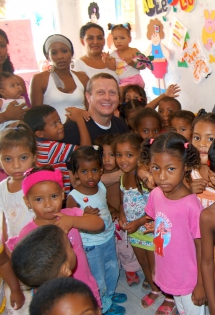Nation has more nonprofits per capita than any country in the Americas except U.S.
Resource will help funders, nonprofits, government officials engage Colombians and their communities
Colombians and others now have greater access and insight into the nation's flourishing nonprofit sector as a result of a groundbreaking website, database and research study.
"To strategically address human needs and help strengthen civil society in Colombia, it first is important to know what the philanthropic landscape looks like," said Van Evans, who conducted the research and created the resource. Evans recently completed his Ph.D. at the Indiana University Lilly Family School of Philanthropy and is a long-time professional in the international nonprofit sector.
"Colombia has a unique and special philanthropic climate," Evans said. "But the extent of the sector was previously unknown, with no aggregate data available. This new resource will increase the visibility of the country's nonprofits, facilitate increased collaboration, and make the nonprofit sector more accessible."
Colombia has more nonprofit organizations per capita than any country in the Americas except the United States, the study found. There are 296,467 nonprofits, or about one nonprofit for every 163 Colombians, Evans estimates. The U.S. has one nonprofit for every 158 inhabitants. Studies from Johns Hopkins University have estimated that Colombia also has the highest rate of volunteerism in Latin America. Home to about 48 million people, it is the fourth-largest country in the Western Hemisphere by population.
The website Evans created will enable Colombians and others to better understand the country's nonprofit sector-including its size, scope and composition-and to better connect with individual nonprofits. The site is driven by an extensive, searchable database documenting the vast majority of nonprofits nationwide. The entire database is available to the public and can be searched based on numerous factors, including National Taxonomy for Exempt Entity (NTEE) codes. Information is presented in an interactive, geocoded map that includes contact information for each organization, as well as a street view. It can be accessed in Spanish and in English.
"This research serves as an institutional benchmark and foundation for public policies and for strengthening all of democratic and participatory civil society," said Bernardo Gonzales, then- deputy director of SuperPersonas Juridicas, Mayor's Office of Greater Bogotá. "This website contains and showcases all of our nonprofits for the world to see, and it will become the connecting point with nonprofit sector entities beyond our borders, opening to us worldwide alternatives in sustainable development."
The study's findings will be made available to the public and to the Colombian federal and departmental governments with recommendations for public policy change and to maintain the national registry, Evans said.
Evans became intrigued with exploring and documenting nonprofits in the country through his work as a consultant to an international nonprofit that provides drop-in centers for street children, which offer them meals, clothing, showers, schools and tutoring. Having worked for the nonprofit in several countries, Evans was struck by Colombians' depth of commitment to civic engagement. For example, the local volunteer board for his nonprofit in Colombia was assembled in just three weeks, compared to the nearly three years it took to establish a similar board for the organization in another South American country.
"Working closely with the Colombian people and their civil society organizations made me wonder, 'What's different about Colombia?'" Evans said. "As I began trying to figure that out, I noted that while Colombians were dedicated to helping others formally and informally, there were very few ways for them to connect or learn from each other nationally, and virtually no philanthropic infrastructure organizations or resources through which donors could research nonprofits before deciding where to give. I thought a nationwide database could help Colombians leverage and build upon their great civic engagement."
The study also found that:
- Colombia has added an average of 11,000 new nonprofits per year for the past 20 years.
- 75 percent of Colombia's nonprofits have been created within the last 15 years or less.
- The overwhelming majority of Colombian nonprofits are in the northwest Andean region, with clusters in the Bogotá central district.
"This research represents an important contribution to knowledge, and we are pleased that Van Evans has been welcomed as a relevant researcher by civil society leaders in Colombia," said Amir Pasic, Ph.D., the Eugene R. Tempel Dean of the Lilly Family School of Philanthropy and a noted expert in international philanthropy.
The Lilly Family School of Philanthropy
The Indiana University Lilly Family School of Philanthropy is dedicated to improving philanthropy to improve the world by training and empowering students and professionals to be innovators and leaders who create positive and lasting change in the world. The school offers a comprehensive approach to philanthropy through its academic, research and international programs and through The Fund Raising School, Lake Institute on Faith & Giving and the Women's Philanthropy Institute. Follow us on Twitter @IUPhilanthropy and "Like" us on Facebook.


